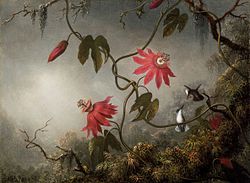| Object history |
Provenance:
The artist. With a Philadelphia dealer. 1944, with Victor Spark, New York; 1944, sold by Victor Spark to Maxim Karolik, Newport, R.I.; 1947, gift of Maxim Karolik to the MFA. (Accession Date: June 12, 1947) |
| Notes |
During a career that spanned almost seventy years, Heade, an ardent naturalist and traveler, painted a great variety of subjects: portraits, luminous salt marsh scenes, seascapes (often with thunder storms), tropical landscapes, hummingbird and orchid pictures, and floral still lifes. Heade had been fascinated by hummingbirds since his childhood, and from 1863 to 1864 he spent six months in Brazil with the intention of publishing a book illustrating hummingbirds-known as the gems of Brazil-in their natural habitat. Although the book ...was never published, the artist did complete some forty-five small paintings of hummingbirds. After two trips to Central America in 1866 and 1870, Heade began a distinctive group of works combining hummingbirds and tropical flowers. These paintings were informed by a worldview recently revolutionized by Charles Darwin. When supporting his theories about evolution in The Effects of Cross and Self Fertilisation in the Vegetable Kingdom (1876), Darwin specifically mentioned the adaptation of hummingbird beaks to fertilize passionflowers.
In Passion Flowers and Hummingbirds Heade depicted two snowcap hummingbirds, small black-and-white birds found in Panama, and the most brilliantly colored species of passionflower, Passiflora racemosa, in a steamy, lush jungle setting. The passionflower is so-named because missionaries saw correspondences between the parts of the flower and the Passion (or sufferings) of Christ. For example, the ten petals represent the ten apostles present at the crucifixion, the corona filaments resemble the crown of thorns, and the three stigmas relate to the nails. In this work, Heade successfully combined his scientific interests and his aesthetic sensitivity. He rendered the birds and the passionflowers accurately in a close-up view but also gracefully composed the winding stems across the surface of the picture and contrasted the cool greens and grays with the dazzling red of the flowers.
Heade painted over one hundred fifty still lifes of Victorian vases with flowers, magnolia blossoms on velvet covered tabletops, and exotic orchids and passionflowers growing in the jungle. One of his tabletop still lifes, Flowers of Hope (1870) was the source of a chromolithograph by Louis Prang and was distributed widely through this medium. His still lifes of flowers in vases were also extensively exhibited during the late 1860s and 1870s. Although Heade was one of the first to reflect Darwin's theories in his paintings of flowers in their natural habitats, other artists were subsequently affected by Darwin's view of the vitality of plants and the interaction of plants with their environment.
This text was adapted from Davis, et al., MFA Highlights: American Painting (Boston, 2003) available at www.mfashop.com/mfa-publications.html. (Museum of Fine Arts) |






